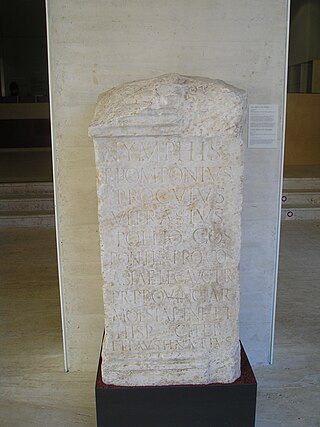Related Research Articles
The gens Arria was a plebeian family of ancient Rome, first recorded in the final century of the Republic, and prestigious during imperial times. The first of the gens to achieve prominence was Quintus Arrius, praetor in 72 BC.

Titus Pomponius Proculus Vitrasius Pollio was a Roman senator, who held several imperial appointments during the reign of Marcus Aurelius. He was suffect consul in an undetermined nundinium around 151; he was a consul ordinarius in the year 176 with Marcus Flavius Aper as his colleague.
Servius Cornelius Scipio Salvidienus Orfitus was the name of several Roman men who lived during the early Roman Empire. They were descendants of Orfitus who was adopted by Servius Cornelius Scipio, an otherwise unknown member of the patrician branch of the Cornelii Scipiones.
Marcus Metilius Aquillius Regulus was a Roman senator of the second century AD. A member of the patrician order, he held the office of consul ordinarius in 157 with another patrician, Marcus Vettulenus Civica Barbarus, as his colleague.
Lucius Dasumius Tullius Tuscus was a Roman senator who was an amici or trusted advisor of the emperors Antoninus Pius and Marcus Aurelius. He was suffect consul in the nundinium of April to June 152 AD as the colleague of Publius Sufenas.
Marcus Peducaeus Stloga Priscinus was a Roman senator active during the middle of the second century AD. He was ordinary consul for 141 as the colleague of Titus Hoenius Severus. An inscription from the Great Theatre at Ephesus mentions a Marcus Peducaeus Priscinus as proconsular governor of Asia in 155/156, whom professor Géza Alföldy, amongst others, has identified as this Priscinus. Priscinus is known only through surviving inscriptions.
Publius Cornelius Dexter was a Roman senator and general active during the middle of the second century AD. He was suffect consul for the nundinium July-September 159; the name of his colleague is not known. Dexter is known only from non-literary sources.
Lucius Novius Crispinus Martialis Saturninus was a Roman senator of the second century. He was suffect consul in either 150 or 151 AD. His life is primarily known from inscriptions.
Marcus Pontius Laelianus Larcius Sabinus was a Roman senator and general who held a series of offices in the emperor's service. He was suffect consul for the nundinium of July-August 145 as the colleague of Quintus Mustius Priscus. Laelianus is primarily known through inscriptions.
Titus Flavius Longinus Quintus Marcius Turbo was a Roman senator who held a series of offices in the emperor's service. He was suffect consul for one of the nundinia in the years 149 through 151. Longinus is known primarily from inscriptions.
Quintus Camurius Numisius Junior was a Roman senator active during the later second century AD. He was suffect consul for a nundinium in the first half of the year 161 as the colleague of Marcus Annius Libo.
Tiberius Claudius Julianus was a Roman senator and literary figure who held several offices in the imperial service during the later second century AD. He was suffect consul during the nundinium of September-October 154 with Sextus Calpurnius Agricola as his colleague.
Quintus Cornelius Quadratus was a Roman senator who held a number of offices in the emperor's service. He served as suffect consul for the nundinium July-September 147 as the colleague of Cupressenus Gallus. Quadratus is best known as the brother of the orator Marcus Cornelius Fronto. He is mentioned four times in the surviving correspondence of the orator.
Quintus Pompeius Sosius Priscus was a Roman senator active in the mid-second century AD, who held a number of offices in the emperor's service. Priscus served as ordinary consul for the year 149 as the colleague of Lucius Sergius Salvidienus Scipio Orfitus. His life is known entirely from inscriptions.
Marcus Gavius Squilla Gallicanus was a Roman senator, who was active during the reigns of Antoninus Pius and Marcus Aurelius. He was suffect consul in 150 AD with Sextus Carminius Vetus as his colleague. He was also proconsular governor of Asia in 164/165.
The gens Salvidiena was a plebeian family at ancient Rome. Members of this gens are first mentioned toward the end of the Republic, and from then to the end of the second century they regularly filled the highest offices of the Roman state.
Quintus Cornelius Proculus was a Roman senator, who was active during the middle of the second century AD. He was suffect consul in the nundinium of November–December 146 as the colleague of Lucius Aemilius Longus. Proculus is known entirely from inscriptions.
Gaius Prastina Messalinus was a Roman senator, active during the reign of Antoninus Pius. He was consul in the year 147 with Lucius Annius Largus as his colleague. Messalinus is known entirely from inscriptions.
Quintus Caecilius Marcellus Dentilianus was a Roman senator, who held several imperial appointments during the reign of Antoninus Pius. He was suffect consul in an undetermined nundinium around AD 150. He is known entirely from inscriptions.
Marcus Servilius Fabianus Maximus was a Roman senator, who was active during the reigns of Antoninus Pius and Marcus Aurelius. He was suffect consul in a nundinium in mid-158 with Quintus Jallius Bassus as his colleague. A native of North Africa, Maximus was the younger brother of Marcus Servilius Silanus, suffect consul in 152, and a relative of Quintus Servilius Pudens, brother-in-law of emperor Lucius Verus.
References
- ↑ Salomies, Adoptive and polyonymous nomenclature in the Roman Empire, (Helsinki: Societas Scientiarum Fennica, 1992), p. 98
- ↑ Géza Alföldy, Konsulat und Senatorenstand unter den Antoninen (Bonn: Habelt Verlag, 1977), p. 257
- ↑ Werner Eck, "Die Fasti consulares der Regierungszeit des Antoninus Pius, eine Bestandsaufnahme seit Géza Alföldys Konsulat und Senatorenstand" in Studia epigraphica in memoriam Géza Alföldy, hg. W. Eck, B. Feher, and P. Kovács (Bonn, 2013), p. 74